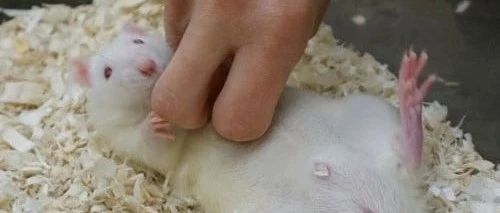
What kind of strange job is it to scratch a mouse every day? After reading it, I even want to try it.
Cute, want to scratch!
during the Ph.D. era, scratching mice was a daily job of Megan La Follett (Megan R. LaFollette).
Yes, tickling a mouse is like tickling a person. She put her right hand into the transparent box where the rats were kept, watching the 15-second countdown on her phone, briskly poking her fingers and scratching the rat's back. Next, she gently grabbed the mouse, quickly turned it into a belly, and continued to scratch the mouse's chest.
(scratching rats at work sounds more fun than touching fish? | Megan LaFollette)
tickle rats. What kind of work is this?
[ play with subjects ]
although the action looks like scratching, scratching a rat (Rat Tickling) is a process of playing with animals. This is an attempt to improve the welfare of experimental animals, and the researchers try to appease experimental animals through this interaction and make their lives happier.
the rats play with other individuals of the same kind, chasing, grabbing, and pounding each other. The action of scratching rats is designed to imitate this process. Around 2000, neuroscientist Jacques Panksepp (Jaak Panksepp) first pioneered this act of playing with mice and proved that when scratching rats, they make sounds that symbolize happiness-ultrasonic waves of frequency 50kHz that cannot be heard by human ears but can be detected by instruments.
(the process of scratching rats is to imitate the play between rats. Megan LaFollette)
many experimental rats live in a monotonous, playless environment, and scratching them should make them feel more relaxed. However, not all rats love to be scratched. Generally speaking, young underage mice prefer this kind of play, and some individuals of the same age are more positive, while others are relatively cold. This difference seems to reflect the different "personality traits" of mice.
(Jaak Panksepp, the researcher who initiated the activity of scratching rats | Washington State University)
scratching rats, how to scratch rats?
scratching rats is not random scratching the movement and duration are very particular. The laboratory where Dr. Laflete worked even offered an online course on scratching rats [2] to teach experimenters how to interact with their subjects.
Get ready to shop magnificent disney cinderella wedding dress and suit your core of personality? Shop now at prices that will make your jaw drop.
(Yes, there is an online course on how to scratch a rat purdue.edu)
the key movements of scratching a rat have the following steps: first, scratch the mouse's back with your finger; next, catch the mouse and gently turn it over; finally, continue to scratch the mouse's chest with your finger-where is the chest? It is the part between its two front claws.
(scratching rats: touching the back, turning over, scratching the chest | purdue.edu)
the action needs to be energetic, the strength is just right, not too light, too slow-and, of course, not too rude. After scratching for 15 seconds, give the mouse a rest and wait at least 15 seconds before starting the next round. Finally, remember that you can't touch a mouse's ass-it will make it feel like you're going to attack.
if they scratch properly, the mice will laugh happily, and they will chase the experimenter's fingers to show that they want more.
(when scratching to the most enjoyable place, the rat will run after the experimenter's hand and send out a happy ultrasonic wave | Shimpei Ishiyama, Michael Brecht)
can I scratch a mouse or hamster in the same way? The answer is no. Because they are different species and play in different ways.
[ does it matter whether the mouse is happy or not? ]
all animals are locked up for experiments, and they also care about their moods. Isn't that a bit hypocritical? But emotional factors aside, it makes sense to make rats happy-it helps to improve the quality of research data and allows people to conduct new types of research.
(LaFollette demonstrates scratching a mouse with a toy mouse | purdueexponent.org)
many times, people test the health effects of various factors on mice. In addition to the factors tested in the experiment, the emotion of animals also affects many physiological indexes. If rats feel pressure and fear about the experimental environment, the measurements may become inaccurate, and it will be more difficult for them to cooperate with the experiment.
making animals happy also plays an important role in cognitive and neuroscience research. For example, some studies have found that if experimental rats are allowed to live in a rich environment, they can perform better in learning tasks and retain more interest in tasks so that researchers can get more meaningful data [3].
(compared with monotonous standard rat cages, a rich and interesting environment seems to be more conducive to cognitive research. L.E.Crawford et al.)
in addition, happy animals also make it possible to study "play" itself. In 2019, an experiment explored the neural activity behind the game by playing hide-and-seek with rats. And in this study, the way the experimenters asked the mice to cooperate with the experiment was not to be seduced by food, but to give them pleasant social interaction-- yes, that is. Scratch them.
(in pleasant interactions, rats learn to play hide-and-seek with people-which can help people study the neural mechanisms behind the play. Annika Stefanie Reinhold et al.)
in the process, rats are not the only ones who are happy. Human experimenters also like to interact with rats-and so do I, who have watched the whole process through the screen. Strange as it sounds, scratching a mouse might be a good job.